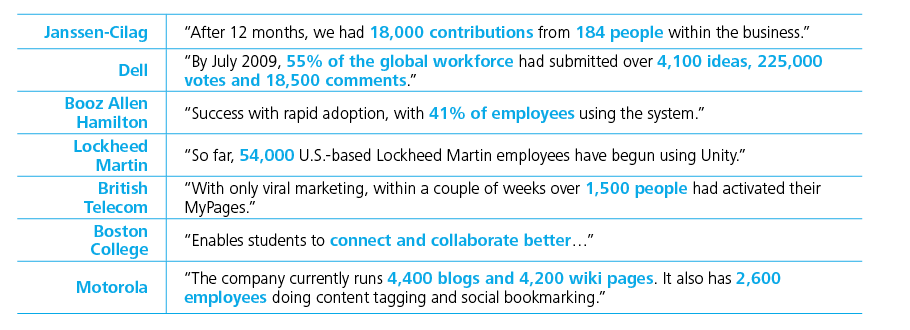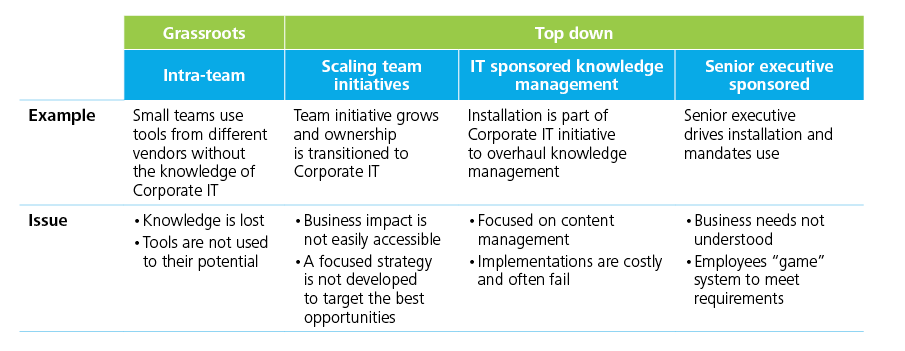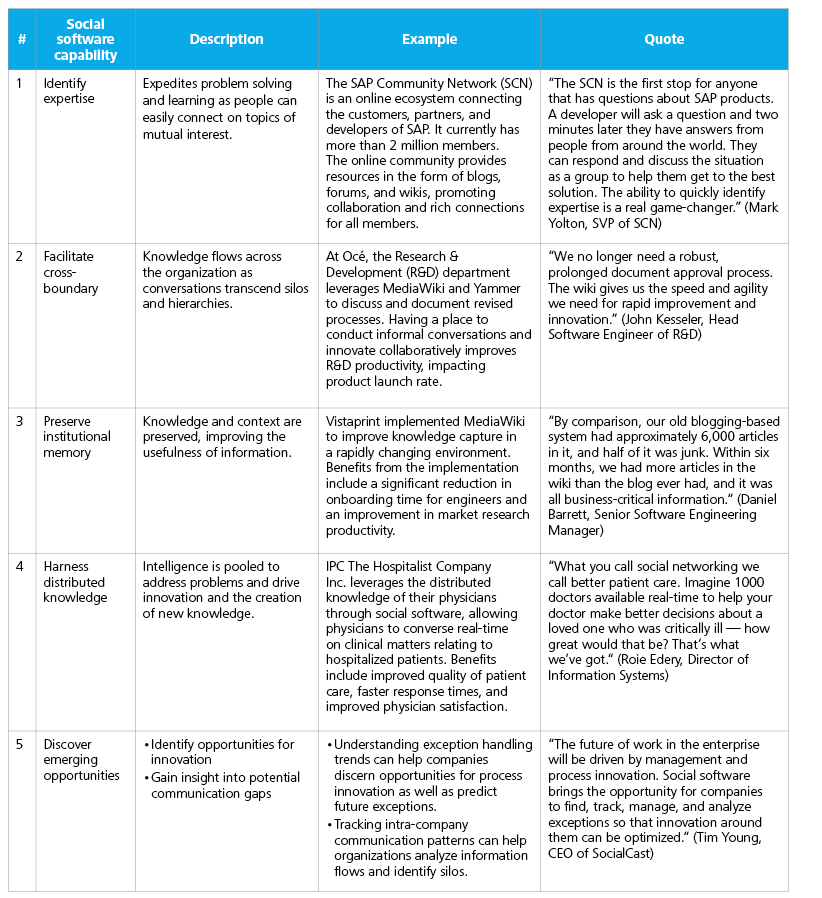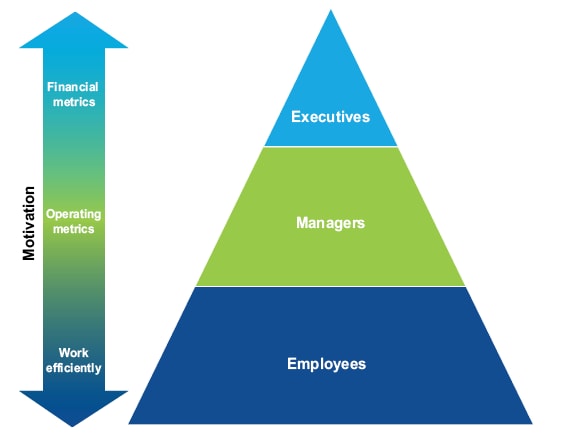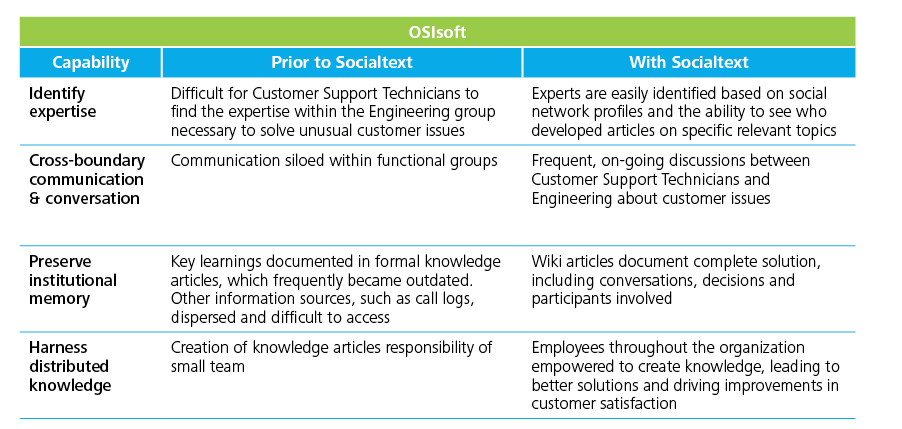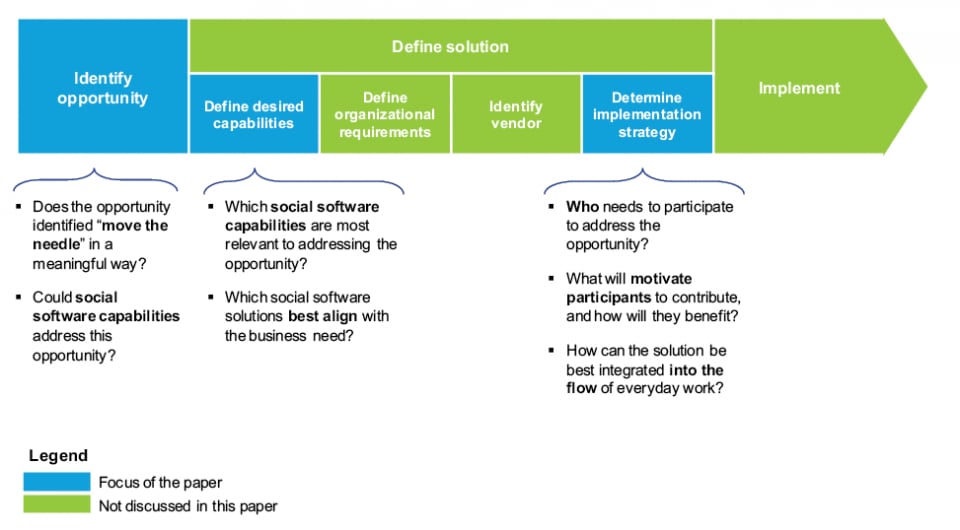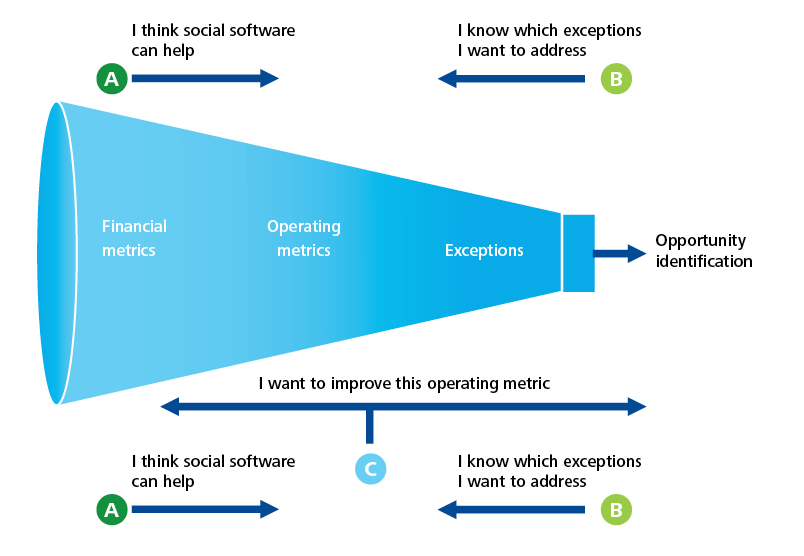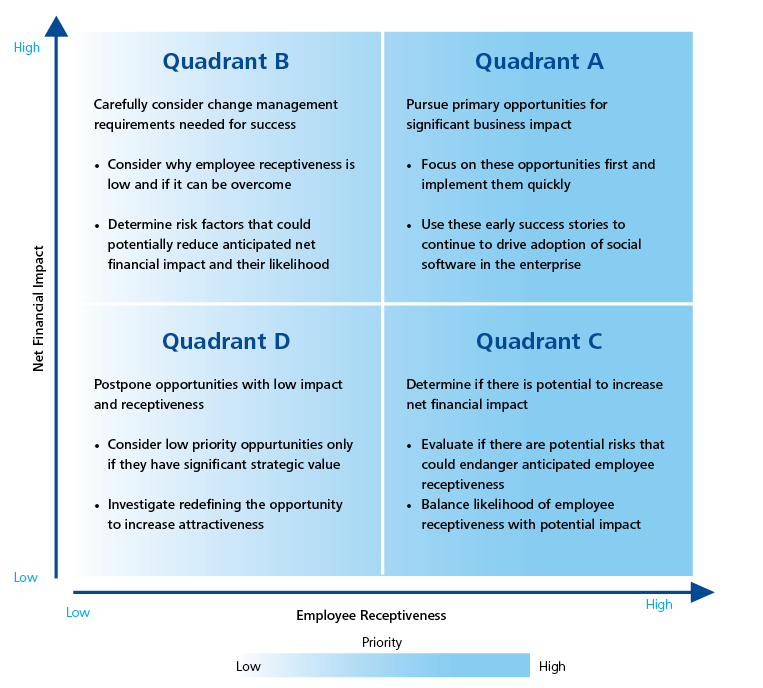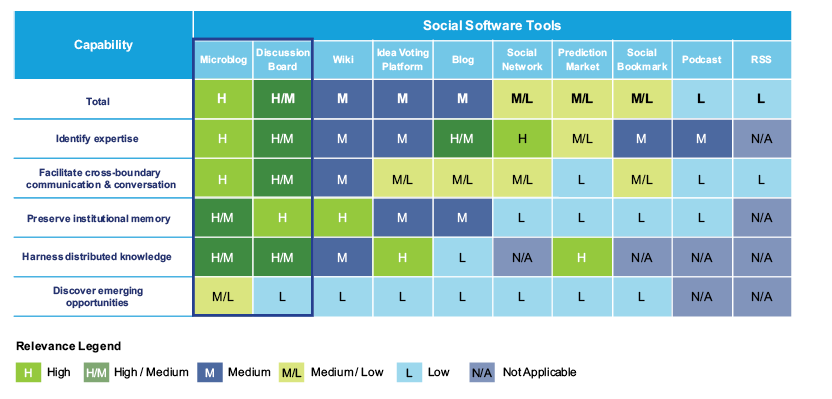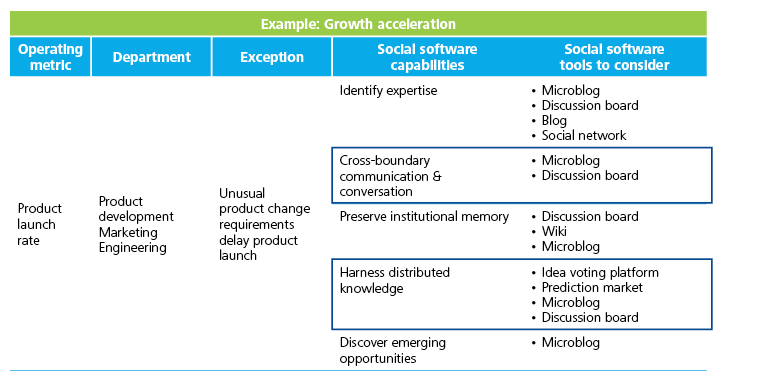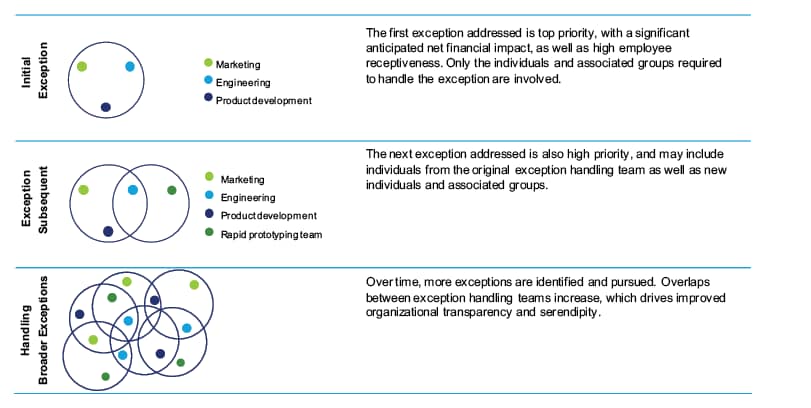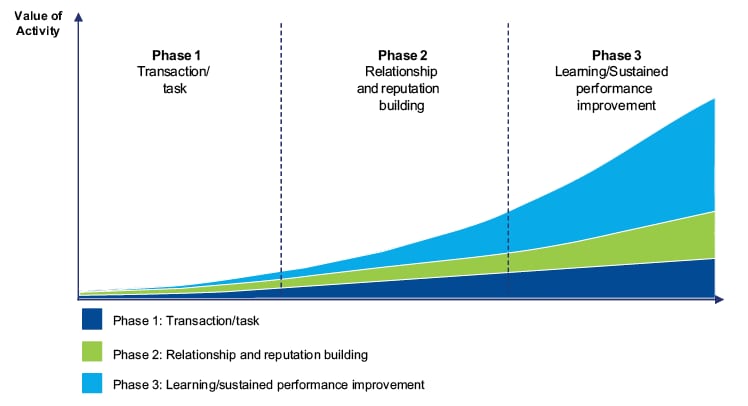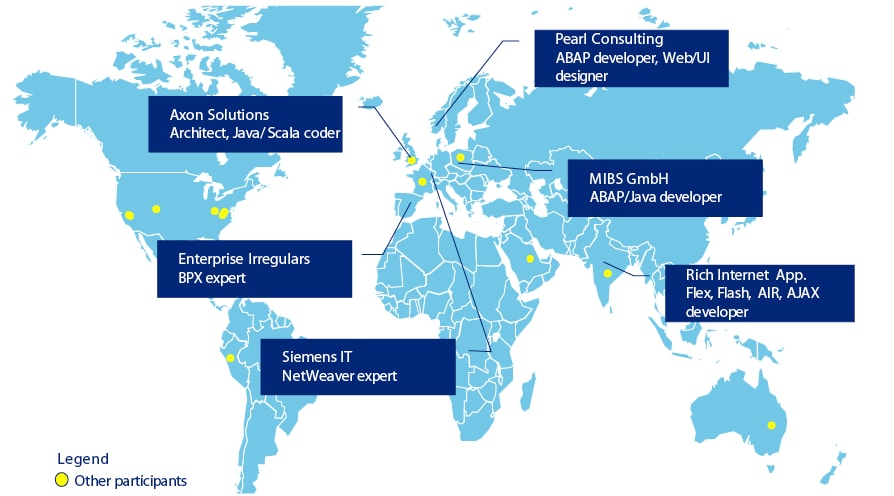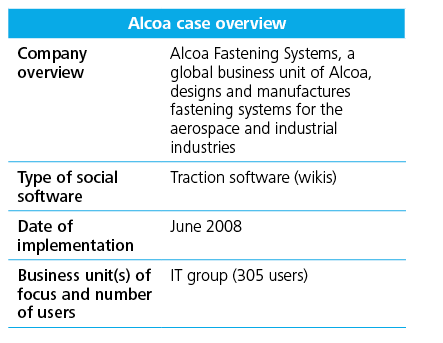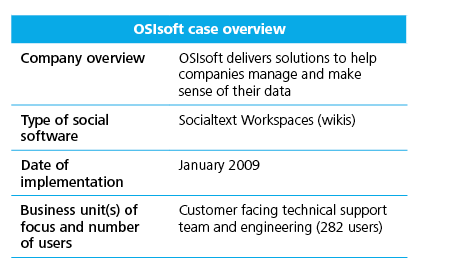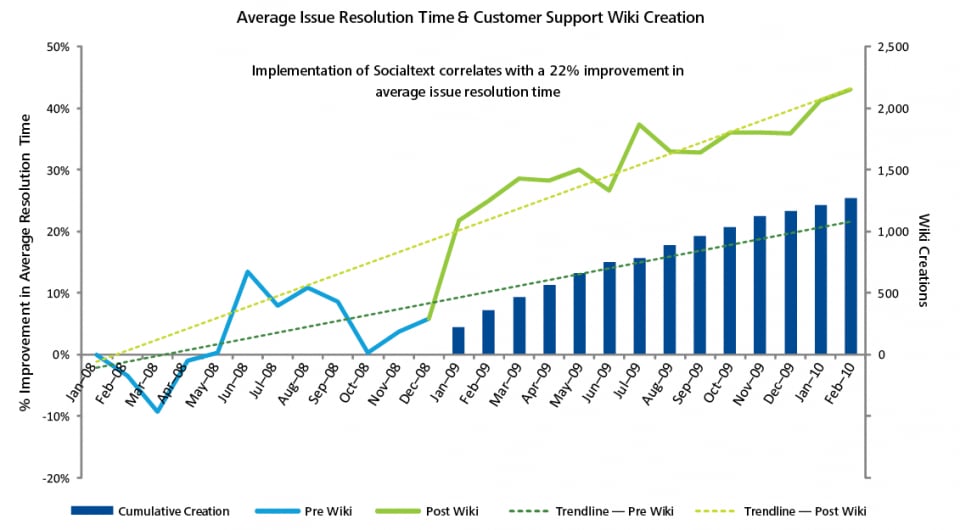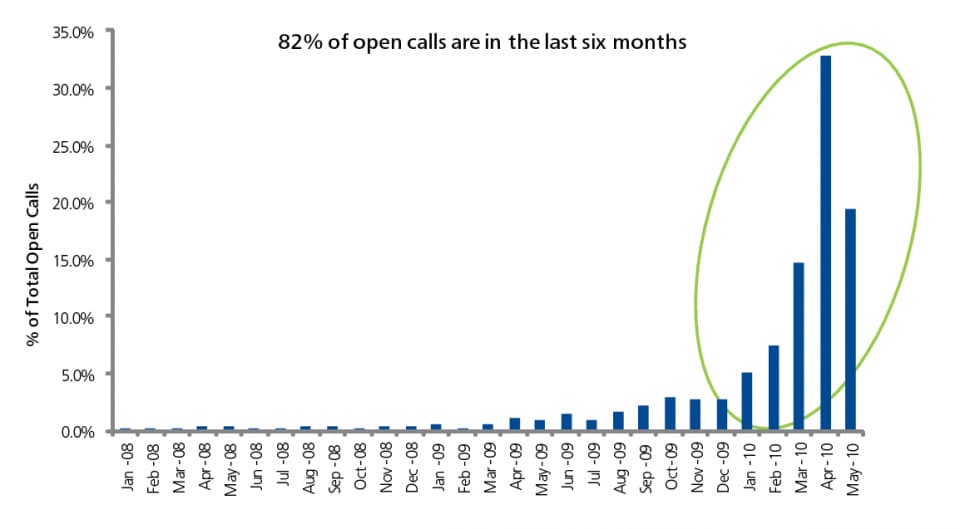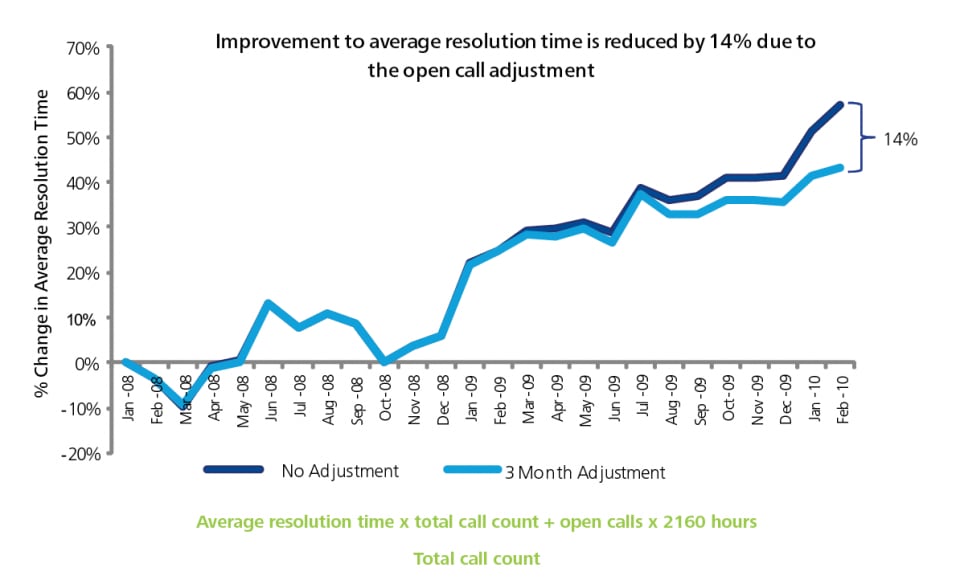Metrics That Matter has been saved

Metrics That Matter Social software for business performance
02 January 2012
 John Hagel III United States
John Hagel III United States John Seely Brown (JSB) United States
John Seely Brown (JSB) United States Duleesha Kulasooriya Singapore
Duleesha Kulasooriya Singapore- Aliza Marks
Social software presents a set of unique capabilities to address operating challenges and improve operating metrics. Companies that embrace this opportunity will have a distinct advantage over their competitors, with the experiences of two early adopters suggesting a strategy for deriving tangible performance improvements and achieving short-term impact with a modest investment in social software tools.
Introduction: When will social software prove itself?
Senior executives are skeptical of the value of social software. Their reluctance is understandable but self-defeating. Social software has the potential to address operational “pain points” and significantly enhance business performance in the short–term and transform it in the long–term. Companies that embrace this opportunity will have a distinct advantage over their competitors; skeptics will likely finish last. Yet skepticism persists, in part, because social software evangelists are their own worst enemy. They have failed to effectively communicate how social software can drive real operating benefits.
Companies that embrace this opportunity will have a distinct advantage over their competitors; skeptics will likely finish last.
Social software has unique capabilities to address current operating challenges and improve operating metrics. The experiences of two early adopters demonstrate that business performance improvements are possible: OSIsoft1 realized a 22% improvement in average time to issue resolution through the customer support team’s use of Socialtext2 wikis. Alcoa Fastening Systems3 experienced a 61% reduction in time spent on compliance activities through the use of Traction Software.4 Both companies believe these improvements would have been impossible without their respective social software tools. Both companies also diverged from traditional implementation strategies. Their experiences point toward a strategy for deriving tangible performance improvements and achieving short-term impact with a modest investment in social software tools.
Current approaches to social software will likely fail
Social software has been getting substantial attention from the business community. Forrester Research (“Forrester”) reported that 65% of companies surveyed are deploying at least one enterprise social software tool.5 Based on early results, most of these enterprise social software deployments will fail to deliver meaningful results. Executives, already deeply skeptical of social software, will likely not continue to invest in tools that have not demonstrated tangible operating benefits. So far, most of the measurable success using social software to improve operating metrics has been confined to small teams and other outliers. Achieving meaningful social software-driven business performance improvements at an enterprise level will require clear objectives rather than the vague goals of better communication and collaboration, which have guided most installations to-date.
Most early adopters have not demonstrated impact
Media coverage of early adopters, especially prominent Fortune 500 companies such as Dell and Lockheed Martin, has played a role in driving interest in social software. Dell credits its social software platform, EmployeeStorm, with increasing the level of engagement and revolutionizing the company’s culture. At Lockheed Martin, a proprietary social technology facilitates interaction between employees and enables them to create and share secure content using wikis and blogs.
Source: Deloitte LLP
Figure 1. Social software adoption quotes
Creating and retaining leaders
Clearly, the interest in social software is high. However, interest does not necessarily translate to meaningful use or performance improvement. Why then do social software advocates focus on adoption, defined as the number of users who have accessed social software, to measure success? Adoption does not measure frequency or sustained use nor does it link usage to performance improvement or business benefits. A Forrester survey found that only 24% of “knowledge workers” (defined as employees who use a computer) use enterprise social applications6—employees are not using the tools.
The companies quoted in Figure 17 are often held up as success stories by the social software community. What is missing from these examples is any concrete measure of the tool’s impact on business performance. While these companies may also have data about social software’s impact on operating metrics, credible examples of large corporations achieving sustained performance improvement as a result of social software are rare.
Defining success through performance improvement
Focusing on adoption as a success metric will likely lead to failure because it engenders resistance. A recent survey found that 64% of companies implementing social software faced resistance from management and 72% faced resistance from users.8 Many senior executives are skeptical that social software can improve performance and are concerned that it will be a distraction and undermine traditional authority structures. Yet in the face of doubt, advocates still focus on adoption. Adoption metrics do not address what matters most to each tier of participants (employees, managers, and executives). As long as adoption is the primary measure of success, resistance, at all levels, can block successful social software deployment.
Alcoa ultimately succeeded with its social software, but the initial resistance generated by focusing only on the number of users threatened the deployment. At first, employees only used the Traction software platform because their managers required it. However, as employees identified and shared specific ways to use the software to improve their performance and work more efficiently, they integrated it into their daily workflow. Operating performance improved—time spent on compliance activities decreased by 61%.9 An employee explained, “One day it just clicked for me. I realized how using the software could really improve my productivity. From that point on, I started using it whenever possible and not just when my boss told me to do so. That’s when I started seeing Traction help me do my job better.”
Enterprise usage is limited by lack of focus
The social software installations that exist in enterprises today were either initiated at the grassroots level by a team with a specific need or driven down from the top as a Corporate Information Technology (IT) initiative or with executive sponsorship.
Each of these approaches to implementing social software has specific issues that limit the benefits (see figure 2):
- Intra-team: When a small team adopts a software tool to address a specific need for a period of time, the team often improves its performance. However, because Corporate IT is not involved, the vendor and tools selected may not be appropriate for the larger organization, no attempt is made to leverage the initiative more broadly, and the knowledge and performance gains are lost when the team disbands. Furthermore, because only a small team uses the tool, it cannot improve cross-boundary communication across the organization.
- Scaling team initiatives: Sometimes an initiative starts within a small team, gains momentum, and is transitioned to Corporate IT. This type of installation can achieve enterprise-wide access but follow-on users quickly become frustrated if they do not see how the tool can help them improve their own performance.
- IT-sponsored knowledge management: Social software is not the next wave of knowledge management, yet some IT groups erroneously try to deploy social software tools under the umbrella of prior knowledge management/content management implementations, many of which have failed. Tools are pushed to executives, middle management, and front-line employees as a new way to communicate, with little focus on how they will improve performance.
- Senior executive-sponsored: The company implements social software because the competition is using it or because it is currently a hot topic in business news. This type of installation typically lacks clear objectives or a strategy to achieve sustainable performance improvement. Employees participate because the leadership demands it but do not truly embrace the tools.
Source: Deloitte LLP
Figure 2. Social software usage
These four scenarios depict how most current social software installations came to exist. Some of these installations have generated a lot of interest and enthusiasm—they seem successful—yet, unfortunately, they fail to garner sustained use or drive meaningful improvement in a company’s operating performance.
Significant challenges lay ahead
In the short history of social software, success has been measured in terms of adoption. But the frequency and nature of sustained usage, and the resulting operating impact, are better indicators of success. Unless the Enterprise 2.0 community focuses on addressing specific business problems and measuring the operating impact, implementing social software within the enterprise will be difficult.

Social software is essential to meet the challenge of constant change
We live in a world of near-constant disruption as defined by the Big Shift,10where rapid technological innovation, globalization, and liberal public policies drive heightened competition. This fundamental shift, to a dynamic world of deep, relentless change, will require companies to embrace informal interactions to remain competitive and avoid further performance erosion. Increasingly, companies need to accelerate the pace at which they respond to change, make decisions, and overcome unforeseen obstacles.
Exceptions are the norm
One consequence of the Big Shift is that, increasingly, employees encounter non-routine issues which break the standard processes. These “exceptions” impede operating processes and drag down business performance across all parts of the organization. Employees spend hours, or days, attempting to find relevant information and expertise in an environment of proliferating information flows. Often, they either guess or create a solution from scratch. The current technologies store information and support standard business processes but fall short of supporting the dynamic informal communications needed for handling exceptions. To improve efficiency and effectiveness, employees need tools that enable navigating across organizational boundaries, connecting to the right people, and accelerating exception resolution.
At both Alcoa and OSIsoft, the increasing number of exception handling activities hampered business performance. At Alcoa, the outcomes of compliance activities were well-defined but the processes to get there were rarely standard. Compliance Leads spent much of their time searching for contacts, communicating via e-mail and phone, sending documents back and forth, finding answers to non-routine questions, and collecting approvals. At OSIsoft, resolving customer issues consumed Customer Support Technicians’ time because they did not have a single source of trusted answers to common questions. Technicians would lose valuable time searching through previous call logs, trying to determine if the solutions in those logs were actually correct, or sending numerous e-mails trying to explain the problem and identify contacts in Engineering who could help resolve the customer’s issue. Neither Alcoa nor OSIsoft had easily accessible, reliable documentation of these interactions and the solution, so similar problems occurred again and again. Without the preservation of institutional memory, each company was bogged down by exceptions.
Alcoa and OSIsoft are not unique. Exceptions—the unanticipated issues that require timely resolution to maintain competitive business performance—occur in every organization. Whether it is a customer that requires non-standard financing terms, a brand manager who needs to find the code for an unusual pallet configuration, or a software developer trying to resolve an issue in code that has multiple dependencies—each is an example of where traditional technologies are insufficient and standard processes break.
Social software capabilities
While social software can be applied against a variety of business challenges to yield performance improvement, exception handling offers one of the best opportunities to prove the concept and overcome skepticism. Social software’s unique capabilities can be used to improve exception handling by allowing employees to communicate across boundaries and benefit from relationships amplified by the digital infrastructure.
For example, Sales Associates at Avaya11 use Socialcast12 microblogs to tap into what their peers are saying. Using the tool, they can glean competitive intelligence, stay attuned to marketplace trends, and access materials to use with clients. When a Sales Associate encounters an exception, he or she searches conversations on Socialcast to see if anyone else has dealt with a similar situation. This easy access to institutional memory saves time. If a Sales Associate does not find a discussion about a similar exception, he or she can post a question to the group, eliminating the time-consuming process of identifying the right person or e-mailing a massive list-serve and receiving redundant responses. Skip Cohen, a Sales Account Manager, explains, “I got frustrated sending e-mails to the list-serve. At times, my inbox would be flooded with 200 to 300 out of office messages. Imagine trying to get work done when you have to sift through all of that! Or I would get 10 folks telling me to go speak to the same person … With Socialcast, I can post a question and the responses are transparent. People add new information to the responses rather than repeating answers.” Cohen and his peers are more effective in their jobs because of their enhanced ability to access and exchange knowledge across the organization.13
The Avaya example illustrates several of the unique ways in which social software can help organizations address exception handling. At the right is a description of all five of social software’s unique capabilities (see figure 3).14
Social software’s unique capabilities distinguish it from the rigid formality of traditional software tools, including knowledge management solutions. Where social software provides a platform for the organization to create new knowledge, knowledge management solutions are generally confined to the capture and transfer of existing knowledge. Although knowledge management installations can improve business performance by facilitating information sharing and retaining intellectual capital, they tend to result in repositories of outdated information because knowledge management has not historically been incorporated into daily work activities.15 In contrast, the unique capabilities of social software support the dynamic flow, and creation, of formal and informal knowledge across the enterprise, embedding knowledge activities into employees’ daily work and driving meaningful improvements in their performance.
While exception handling is a good first target, once the tool is being actively and richly used, social software ultimately creates an environment where serendipity is more widely to occur. Serendipitous encounters occur when a user finds valuable new information and resources or connects with someone with a needed expertise, when the user was not even actively searching for those resources or expertise. These chance encounters enrich the user’s professional experience and can lead to new ideas and opportunities. Organizations that use social software to complement traditional enterprise solutions and increase the possibility for serendipity will be better equipped to maneuver through a shifting business environment.
Source: Deloitte LLP
Figure 3. Five unique capabilities of social software
Extreme performance improvement is achievable
The experiences of Alcoa and OSIsoft prove that social software can achieve meaningful improvements. How did they succeed where so many others did not? Both Alcoa and OSIsoft employed a simple tactic: they avoided focusing on adoption. Rather, they identified specific operational pain points in the business that social software could address. By focusing on something tangible, broadly relevant, and widely acknowledged as a problem, they overcame initial skepticism.
Aligning on operating metrics
As Alcoa and OSIsoft learned, connecting social software’s capabilities to outcomes that matter to each tier of participants aligns the organization to support the new tool. Employees across all levels of the organization will use the tool if doing so will help them meet performance targets, receive recognition, or be rewarded. Aligning the organization requires focusing on something everyone cares about—key operating metrics (see figure 4).
Operating metrics are near-term indicators of an organization’s performance and measure the success of key business processes. Showing how a social software tool can improve an operating metric can prompt managers to use social software and to encourage their employees to use it as well. As they realize productivity gains and improve their overall performance, employees will use the tools more. As improved operating metrics lead to improvements in the financial metrics they are accountable for, executives will be motivated to use and support social software as well.
15 Exploring Failure-Factors Of Implementing Knowledge Management Systems In Organizations: May 2005 (Journal of Knowledge Management Practice): http://www.tlainc.com/articl85.htm
Figure 4. Motivational alignment across tiers
Focus on OSIsoft
When OSIsoft decided to implement social software, it targeted one of its key operating metrics—average time to issue resolution. Changes in this metric affect the company’s financial performance. Customer Support Technicians saw immediate improvement in their average time to issue resolution when they began to use Socialtext and the metric continued to improve with increased usage. Moving the needle on average time to issue resolution required employing four social software capabilities (see figure 5) through Socialtext:
- Identity expertise: The Customer Support Technicians seamlessly connect with other knowledgeable Support Technicians and informed Engineers to resolve specific customer issues. Technicians no longer waste time searching for experts.
- Cross boundary communication & conversation: “Everyone is conversing and trying to get to the core of particular problems. Specifically, the increase in communication between Engineering and Customer Support has been significant. Socialtext has provided the biggest step change in terms of performance.”16 The increase in dynamic, informal communication between the two groups has improved the overall knowledge level, removed obstacles to taking quick action, created new knowledge, and enabled them to address previously unknown or unsolved customer issues.
- Preserve institutional memory: When Customer Support Technicians face a non-routine problem, they can find reliable, vetted solutions, rather than searching through call logs for “possible” solutions, or recreating the solution. By creating wiki articles with complete solutions, the technicians build institutional knowledge around all customer issues and avoid the time sink of wading through call logs or reinventing the wheel each time a customer reports a similar problem.
- Harness distributed knowledge: There is a common adage among many companies with a distributed workforce: “If only OSIsoft knew what OSIsoft knows.” Without a robust and centralized collaboration platform, OSIsoft could not access the tacit knowledge of its Support Technicians and Engineering staff. By making it easier for employees to contribute to knowledge creation, OSIsoft found better solutions to customer issues. The platform has also shifted the culture. One Support Technician noted that Socialtext “has brought everyone into the fold of knowledge creation and maintenance and raised awareness of its importance. Now, you don’t have to be someone in a special group to write up a useful tech note. People see it as a collective responsibility.”
Source: Deloitte LLP
Figure 5. Four social software capabilities leveraged by OSIsoft
Source: Deloitte LLP
Figure 6. OSIsoft highlight
The Socialtext workspaces enabled OSIsoft to realize value almost immediately. Reductions in average time to issue resolution translated to cost savings and increased productivity; the team suspects it has also improved customer satisfaction. Managers and employees valued the tool’s impact on their work, and once the OSIsoft executives saw the tangible performance improvements, they also embraced the use of Socialtext through continued funding and support.
Recipe for success
The OSIsoft example outlines a recipe for success: identify a pain point that can be addressed by social software, target the relevant operating metric, and apply social software capabilities to improve the operating metric. Focusing on the operating metric aligned all levels of the organization to use the tool to improve the metric. Because exceptions cause “pain” in operating processes and dealing with them gets in the way of improving those processes, targeting exception handling is one way that social software can directly affect operating metrics and drive performance improvement (see figure 6).
Companies must focus to move the needle on business performance
Too often, companies implement social software without clear business objectives or a strategy for making an impact on organizational performance. These efforts typically fail.
Alcoa’s initial experience illustrates why. Executives believed social software could be beneficial in the technology department but were not sure what it should be used for or how it should be structured. Alcoa rolled the tool out cold to the entire technology group. The organization subsequently spent 12 months trying to figure out what to do with it. Some users became disinterested; others felt frustrated that they were “going the road alone.”17 In retrospect, Alcoa acknowledges it would have realized value from the tool more quickly if it had taken time upfront to identify pain points and to provide structure before rolling the tool out to users.
Alcoa is a rare example of a company that managed to survive a big bang roll-out and achieve real business results. Most often, organizations need a focused implementation approach to target the exception handling situations with the greatest potential to improve operating performance, and thereby improve key financial metrics.
A targeted approach to social software implementation
A focused approach enables a company to derive tangible performance improvements and achieve near-term impact with modest investment in social software tools. While this approach to social software largely mirrors a traditional IT implementation strategy, certain components are unique and must be tailored to social software’s capabilities as well as to the “fundamental shifts re-shaping the business landscape” (see figure 7).18
- Opportunity identification: The success of a social software deployment hinges on selecting exception-focused opportunities that will have a meaningful impact on operating and financial metrics and then using change management activities to drive employee receptiveness.
- Social software capabilities: The nature of the opportunity will determine which of the social software capabilities are most relevant and which tool best supports them.
- Implementation strategy: Aligning the implementation around the identified set of opportunities, rather than around the organizational structure, removes the constraints of organizational hierarchies and facilitates targeted exception handling where every participant is relevant to the solution and realizes value from the outcome.
Source: Deloitte LLP
Figure 7. Focused social software approach
Identify opportunities for impact
Companies may arrive at the decision to pursue social software from various directions (see figure 8). Executives may target specific strategic challenges in pursuit of improving financial metrics (see method A). Business Unit Leaders may take a ground-floor approach, having already identified key exception categories they need to address to improve performance (see method B). Alternatively, Executives or Business Unit Leaders may have identified a troubling operating metric that needs improvement (see method C). No matter the starting point, exploring the full spectrum of impact (on financial metrics, operating metrics, and exceptions) is a critical part of selecting an opportunity. By approaching social software from multiple angles, companies can identify the opportunities that will move the needle and drive improvements in operating and financial metrics. The growth acceleration example on the following page illustrates how a company might use this framework.
Source: Deloitte LLP
Figure 8. Strategic approach to opportunity identification
Growth acceleration example
The executive team of a consumer goods company wants to accelerate its rate of growth. In analyzing the company’s growth drivers, it identifies a disconnect between the amount invested in R&D and the launch rate of new products. Further investigation reveals several factors contributing to the decline in product launch rate, most notably that developers spend significant time dealing with unusual product change requirements, which directly impacts product development time. Having identified this critical exception, the company defines the opportunity: to improve product launch rate, it must improve the organization’s ability to handle change requirements by empowering the product developers. As Marketing and Engineering typically help the product developers define a solution when unusual change requirements arise, individuals from those functions will also be involved in addressing the opportunity.
This opportunity is tangible, significant, and motivational. Addressing it will resolve a material pain point and impact key operating and financial metrics. Employees, managers, and executives are eager for a solution that will help them achieve these goals.
Most organizations will have numerous opportunities that can be addressed by social software and can materially improve performance. The matrix (see figure 9) provides a framework for decision makers to analyze and prioritize the portfolio of opportunities based on anticipated net financial impact and employee receptiveness. The opportunities in Quadrant A have both high anticipated net financial impact and high employee receptiveness. The organization can drive significant impact in the near-term by focusing on these opportunities. Opportunities in Quadrant B (high anticipated financial impact but low employee receptiveness) will require more attention to change management and consideration of why employee receptiveness is low and whether it can be overcome. The opportunities in Quadrant C (low net financial impact but high employee receptiveness) offer some value as a secondary focus, but will be more attractive if they can be reframed to increase the anticipated financial impact. Opportunities in Quadrant D are not attractive, and should not be pursued unless there is significant and compelling strategic value, or they can be restructured and moved to a different quadrant. In all cases, decision makers should assess the likelihood of any risk factors that would reduce the anticipated financial impact or otherwise make the opportunity less likely to succeed.
Source: Deloitte LLP
Figure 9. Opportunity decision matrix
Define desired capabilities
Once the organization has identified an attractive opportunity, how can social software’s unique capabilities address the pain point? We return to our example of a growth company that has decided to address a declining product launch rate resulting from unusual product change requirements. All five social software capabilities could enhance a product developer’s ability to handle change requests:
- Identify expertise: Easy access to experts will help product developers quickly assess change requirements.
- Enable cross-boundary communication & conversation: Better communication will enable Product Development, Marketing, and Engineering to reach clarity on product requirements earlier in the process.
- Preserve institutional memory: Capturing the communications, approvals, and relevant product requirements will increase accountability, improve process efficiency, and record important learning for future product development work.
- Harness distributed knowledge: Leveraging the collective knowledge of the product development community will accelerate and improve the quality of product developers’ solutions.
- Discover emerging opportunities: Metadata will allow the entire organization better insight into upcoming features and requirements, reducing the potential for unexpected changes in product requirements late in the development cycle.
Source: Deloitte LLP
Figure 10. Social software capability and tool heatmap
Although all of the capabilities may be relevant, certain capabilities will be more critical than others for addressing a given opportunity. In this example, cross-boundary communication & conversation, and distributed knowledge are most important. Understanding which social software capabilities are most critical for the opportunity leads directly to the choice of social software tools that will meet the specific needs of the company. As the heat map (see figure 10) shows, not all social software tools support the five capabilities to the same level (although most vendors group multiple tools into a solution package).
Revisiting the growth acceleration example, a likely solution would incorporate tools such as microblogs and discussion boards, which support the two most critical capabilities: cross-boundary communication & conversation and distributed knowledge (see figure 11).
Source: Deloitte LLP
Figure 11. Opportunity for growth acceleration with social software
Source: Deloitte LLP
Figure 12. Social software implementation strategies
Determine implementation strategy
There are many different ways to approach an IT implementation, and all have benefits and challenges. Figure 12 illustrates these possible approaches. In Section 2 we described the “who” behind most current social software installations (Grassroots and Top Down); with the implementation approaches described here, we are focusing on “how” to achieve defined business objectives in future social software installations.
Organization-driven approaches
In an organization-driven approach, participants are involved because of where they are located in their organizational hierarchy. Typically, organization-driven approaches encompass a larger number of initial users, which can increase the potential for transparency and serendipity. However, whether Big Bang, T-Strategy, or Functional, organization-driven approaches tend to fail because they do not focus on a specific business pain point, and too many of the intended users derive little tangible value from using the tool.
Opportunity-driven approaches
An opportunity-focused approach involves only the employees and groups specifically needed to address the targeted opportunity. Securing participation from different functional groups and approvals from various senior managers across the organization can be logistically challenging; however, the potential for successfully driving business performance improvement is much higher with this approach.
While an opportunity-driven approach can either be exception-focused or process-focused, our research indicates that an exception-focused approach has the greatest likelihood of driving significant business performance improvements in the near-term. Because they all feel the current pain of the exception, the intended users are motivated to participate in its resolution using the social software tool. Their successful use of the tool leads to increased organizational agility and improved business performance.
Source: Deloitte LLP
Figure 13. “The ripple effect” — Growth acceleration example
There are challenges to an exception-focused approach. The smaller number of participants limits organizational transparency as well as opportunities for serendipity. Also, the targeted exception might not be fully resolved if all of the appropriate groups are not identified and included in the implementation. The tighter focus means that more care must be taken to get the focus right with an exception-driven approach.
The ripple effect
As the organization builds confidence and proficiency using a social software tool to resolve a targeted type of exception, it can expand use of the tool to address additional attractive opportunities (exceptions with significant impact and high employee receptiveness). This expanded use of the tool still centers on an exception, involving only the people needed to resolve the specific issue. As subsequent exceptions are identified, the tool is extended to additional individuals (see figure 13). Over time, the user base expands to include people from across the organization with numerous overlaps between exception handling teams. Rich content is developed as a result of exception handling, and communities form as individuals build relationships based on interests and expertise, leading to greater transparency and opportunity for serendipity.
Social software approach: Summary
While some organizations have succeeded using a less-targeted approach, companies that pursue an exception-focused implementation, identify the best opportunities, and select the most appropriate tools will reap the most significant and measurable improvements in business performance.
Source: Deloitte LLP
Figure 14. Social software approach
Long-term benefits of social software are transformative
The near-term performance improvement driven by enhanced exception handling creates tangible benefits that align every tier of the organization in support of the social software tools. There are also longer-term benefits that can be achieved through the use of social software. Specifically, the unique capabilities of social software create a foundation for innovation and sustained learning.
Social software maturity curve
The social software maturity curve (see figure 15) illustrates how the nature and value of activities changes over the lifecycle of social software usage.
Phase 1: Transaction/task
In the transaction/task phase, users test the tool for reliability and usefulness, using it to resolve narrowly framed performance issues or exceptions. Participants ask and answer questions, and create and join communities of interest. Two elements drive continued use in this phase: 1) there must be a low barrier to participation; and 2) users must get positive feedback quickly. If participants can contribute with modest effort and quickly receive resolutions or see their contributions valued, they will use the social software tool more frequently.
Phase 2: Relationship and reputation building
As a result of the interactions in the first phase, users typically develop reputations and make contributions that augment their profiles within the context of the social software environment. As a result, other users will more clearly understand the expertise and helpfulness of their colleagues.
Source: Deloitte LLP
Figure 15. The social software maturity curve
As users develop a better sense of fellow participants, they naturally form relationships and engage in discussions around shared expertise and interests. Because of the growing richness of content and information, the social software platform becomes more attractive to a wider audience, more people participate, and the platform becomes more useful. The platform becomes a forum for users to engage in discussions around problem-solving and lessons learned.
Phase 3: Learning/sustained performance improvement
The relationships that form in Phase 2 increase the likelihood that new knowledge is generated as a result of ongoing interactions. In the learning/sustained performance improvement phase, groups of individuals work together around areas of common interest or specific challenges within the organization. As informal teams form and solve performance challenges, a positive feedback loop encourages further participation; other users want to solve key challenges within their own areas of interest as well as be affiliated with success stories.
As an organization’s use of social software matures, the initial focus on narrowly defined issues provides a platform for reputation and relationship building. These relationships allow teams to form to address even more substantial performance issues. The resulting learning and innovation can be a competitive advantage for the organization. In practice, sustained performance improvement in Phase 3 manifests itself in three ways: knowledge creation, pattern recognition, and collaborative innovation.
Sustained performance improvement: Knowledge creation
The SAP Community Network (SCN) platform was launched in 2003 as a resource for customers, partners, and developers implementing SAP’s NetWeaver solution. Initially, it was transactional: a developer would post a question, and someone else would post a solution. Over time, users began to build reputations, connect with one another around shared interests, and form ad-hoc teams to solve specific issues.
Source: Deloitte LLP
Figure 16. ESME founding members
The Enterprise Social Media Experiment (ESME) was one such group, whose members came together based on their SCN relationships and actually created new knowledge (moving into Phase 3). Through an online conversation, a handful of SCN members discovered a communication need within SAP and decided to design a Twitter-like solution to address business process problems occurring inside the enterprise and to submit their solution to SAP’s DemoJam competition. To develop their solution, the ESME team had to learn from and leverage existing knowledge, as well as create new knowledge. The founding members, and the others who joined the team later, represented a broad range of technical and business skills from all over the world. Each team member had been connected to another, directly or indirectly, through the SCN.
They completed the project in less than three months, creating a product in their spare time that could have taken a full-time team as long to complete. They drove process innovation within SAP through improvements that substantially enhanced SAP’s communication capabilities. The ESME team’s success demonstrates the performance improvement that can result as a social software platform like SCN matures.
Sustained performance improvement: Pattern recognition
Sustained learning and performance improvement can result from pattern recognition. As discussed previously, without the tools to identify the experts or the information needed to resolve an exception, employees must create a solution from scratch. However, using social software’s capabilities, employees not only solve problems faster by connecting with relevant resources but, as they have visibility into previous resolutions of the exception, they can solve similar exceptions faster. This results in increased knowledge and expertise of the entire group. Innovation occurs as individuals have more time and energy to think about more effective or efficient solutions, and employees are more empowered and motivated to improve business performance.
Sustained performance improvement: Collaborative innovation
Sustained performance improvement can take the form of collaboration that leads to innovation. This was the case at Ensign-Bickford. As Ensign-Bickford quickly grew to over 400 employees, it needed improved solutions to manage and exchange information. Specifically, the rapid prototyping division needed a more efficient tool design process and better communication between the Tool Design and Manufacturing Engineering teams. Tooling and design efforts were isolated from Engineering and frequently required substantial rework and overtime hours; often the tools developed did not meet the Manufacturing Engineer’s requirements.
Ensign-Bickford ultimately installed Traction software to help bridge the communication gaps. Once the software was deployed, the teams began using wikis to create a “tooling request form” through which all engineering service requests could be directed. The teams used these forms to convey limited amounts of information. However, the dynamic nature of the software enabled the form to evolve into an article that defined the tool request; Engineers and Tool Designers added comments, attached pictures, conducted conversations, and documented decisions on the wiki. Each request article became a continuous feedback loop as tool developers and engineers honed in on the exact requirements and leveraged the collective expertise of the organization to develop the desired prototype. This collaborative innovation substantially reduced rework; overtime hours dropped from 10 hours to less than one hour (per week) with constant workflow.
Each of these examples illustrates how social software is first used to facilitate transactions, often to solve a narrow problem, and evolves into a platform supporting sustained learning and performance improvement across the organization.
Conclusion: Social software is worth your time
Social software has the potential to improve business performance in the short-term and transform it in the long-term. Yet somehow, cast as a new way to communicate, social software ends up seeming trendy or, worse, a waste of time. Executives are skeptical of its value and wait for it to go away. This is a mistake.
In the world of near-constant disruption and intense competition, employees increasingly face an array of non-routine issues, “exceptions” that standard processes cannot manage. Exceptions are not exceptional—they are the norm. Exceptions are occurring in every part of the organization, in every industry. Handling these exceptions drags down operating performance unless employees have the tools to effectively and efficiently resolve them. This is why executives cannot afford to ignore social software. Social software has unique capabilities to improve exception handling with tools that enable dynamic and informal communication to connect people more easily and provide the ability to search and create across knowledge flows. Social software, applied against the problem of exception handling, can directly and measurably impact operating metrics and improve business performance.
Skepticism about social software is understandable. Although many organizations are installing or considering social software, usage of those solutions remains low, and few organizations can point to measurable results in business performance. Most have focused on adoption as a proxy for success. Social software will very likely fail if its advocates focus on anything other than tangible improvements to operating performance as a primary indicator of success.
Positioning social software as a means to impact key operating metrics through exception handling will overcome skepticism, align the organization in support of the tools, and drive strong, sustained usage. Success requires companies to focus on opportunities with the potential to move the needle on organizational performance and hone in on the social software capabilities that can best address the opportunity. Implementation must be opportunity focused, with usage and benefits building over time. Taking a big bang approach to implementation has historically been a quick path to failure.
By more effectively targeting high impact opportunities for social software, companies can generate material, near-term operating results with modest investment. Longer-term, social software can lead to innovation and sustained learning, as richer usage creates a foundation for knowledge creation, pattern recognition, and collaborative innovation.
Companies must act quickly and decisively. Early adopters of social software have the potential to reap financial rewards and develop skills and experience that can build a stronger competitive position over time.
Appendix
Business case details
Alcoa had two main objectives for its software implementation:
- Increase productivity for a globally dispersed team
- More efficiently manage Sarbanes-Oxley requirements to enable compliance site consolidation
- Increase productivity and effectiveness of project management teams
- Create a workspace for informal work:
- Increase asynchronous work among employees
- Relocate IT contract work and communication to wiki pages to reduce exception handling
Source: Deloitte LLP
Alcoa Software implementation objectives
Software implementation strategy
The software was implemented in 2008 to a pilot of 50 users. No time was spent on creating the structure or seeding the wiki with information prior to the pilot. This resulted in employees spending significant time figuring out how to organize their work. Over the course of 12 months, Alcoa developed a usable structure to organize work within the tool and learned how Traction could be leveraged to help employees improve performance. It identified compliance and project management as two key areas where the use of Traction could help improve user efficiency. Use slowly increased as users began to understand how Traction could help them work more productively and meet their performance objectives.
During the time period that the reduction in hours was achieved, compliance activities were consolidated to one physical location, although the same amount of output was required. Though the entire reduction in time spent cannot be attributed to Traction, the IT Director believes that without Traction the team would not have been able to consolidate the compliance work and achieve compliance hour reduction to the same extent.
Key benefits of software implementation
- Identifying expertise: Before Traction, identifying expertise was difficult and required communicating through formal organizational hierarchies. Once expertise was identified, the process to staff resources was also time consuming. Often, managers were unwilling to share resources with other managers for specific tasks. With Traction, each employee has a profile that facilitates efficient expertise identification, which enables employees to interact more and form communities around common expertise and interests.
- Enabling cross-boundary communication & conversation: Before Traction, Alcoa’s geographically dispersed IT Compliance team spent significant time on status calls and communicating via e-mail because teams did not have any other means to communicate. After the implementation, fewer status calls and e-mails were necessary as teams had a workspace where they could conduct conversations and exchange information.
- Preserving institutional memory: Before Traction, information was dispersed among multiple resources and employees needed significant time to find the correct information. Often, employees had to “reinvent the wheel” when they encountered non-routine issues. Traction created a single source of truth that is continually updated and that preserves content, so that employees could refer to it when dealing with exceptions or troubleshooting issues.
- Harnessing distributed knowledge: Before Traction, e-mail was the primary way employees leveraged the distributed knowledge of the organization to solve difficult problems. Traction allowed employees to create wiki pages to address specific problems and build upon each other’s knowledge to collaboratively develop solutions. It also treats resources as one large pool of expertise that are pulled onto projects as needed, regardless of where they sit in the organizational hierarchy.
Source: Deloitte LLP
Figure 17. Alcoa compliance activity improvement
Additional insight: User perspectives
“Traction Software is the place where informal work gets done.”
“With Traction Software I can post meeting notes and assign action items to individuals. Then, they can go into the tool and write comments to update the group on the status of their action items as well as post deliverables. It greatly increases transparency and streamlines communications.”
“What sold me on Traction Software is I realized how it can help me do my job better. Traction helps me get work done faster and allows me to communicate more effectively with my colleagues.”
“With Traction, people take ownership for their area of expertise on the tool. They provide help to other projects if they have the knowledge needed to contribute.”
“With Traction, people are pulled in to solve problems based on their expertise on short notice. Before Traction, we simply weren’t able to do this.”
“Traction has increased transparency around resource allocation and made it easier for managers to find the expertise they need quickly.”

OSIsoft wanted its software implementation to help improve quantitative and qualitative performance metrics in three areas:
- Information usability
- Build and share comprehensive and accurate knowledge on how to solve customer issues with OSIsoft solutions
- Better manage knowledge over time by facilitating an easy and transparent knowledge refresh process
- Eliminate “urban myths” and other ineffective issue resolution strategies
- Issue resolution
- Decrease time-to-resolution for Tech Services cases through high-quality, up-to-date, accessible knowledge
- Increase the value of solutions provided
- Reduce the reliance on mentors and developers to resolve issues by creating a “one-stop shop” for solutions
- Enable remote engineers to provide high-quality support
- Reduce time to proficiency for newly hired engineers
- Customer satisfaction
- Improve customer loyalty, satisfaction, and SRP renewal rate via improved web-based self-service support19
Source: Deloitte LLP
OSIsoft software implementation objectives
Software implementation strategy
OSIsoft’s implementation was executed in three phases. In Phase 1, a cross-functional team spent three months building out the wiki and leveraging existing materials to make it a “one-stop-shop” prior to roll-out. It engaged early adopters/leaders in Customer Support and Engineering for feedback. In Phase 2, OSIsoft rolled-out the wiki tool to the Customer Support and Engineering teams over three recorded training sessions. To promote adoption, the team facilitated a contest with a reward for the most valuable wiki contributions. In Phase 3, OSIsoft incorporated performance incentives to motivate ongoing usage and to promote quality over quantity. It provided ongoing support to answer questions, share best practices, and give advice on issues. OSIsoft continues to nurture the community and incorporate feedback to increase usage and usefulness of the tool.
Results of software implementation and key insights
Implementation of Socialtext at OSIsoft correlated with a 22% improvement in average issue resolution time. It was the key initiative during this time period that focused specifically on improving call center productivity. Socialtext gives employees a single source of truth for reliable solutions that can quickly be provided to customers.
Key benefits of software implementation
- Identifying expertise: Before Socialtext, OSIsoft did not have a place to easily record and keep up-to-date expertise, which limited expertise identification. Experts were identified through word-of-mouth communication, which could take significant time. Using Socialtext, employees are able to identify expertise based on the contributions employees make to wiki articles, increasing expertise identification; the increase in expertise identification has helped decrease resolution times and has increased learning.
- Enabling cross-boundary communication & conversation: Before Socialtext, OSIsoft communicated primarily through e-mail; valuable information was not available to the entire organization, and communication between the support and engineering groups was limited to person-to-person discussions with varying effectiveness. Socialtext made information available to the entire organization. Communication between the support and engineering groups has increased because Socialtext makes it easier for them to communicate.
- Preserving institutional memory: Before Socialtext, information was dispersed among multiple resources, so it required significant time to find the correct information. Often, employees had to leverage multiple resources to create a solution. Socialtext allows for a single source of truth that is collaboratively updated and organized by all call center employees, preserving institutional memory and increasing information findability.
- Harness distributed knowledge: Before Socialtext, OSIsoft relied on knowledge articles published by a few individuals (which only covered common issues) and static call recordings (which offered incomplete solutions) as its source for call resolution best practices. After implementing Socialtext, OSIsoft harnessed the power of collective intelligence to collaboratively and asynchronously develop its call resolution best practices by enabling all employees to create best practices for less common problems. This has increased the ability to resolve difficult calls while reducing learning costs.
Source: Deloitte LLP
Figure 18. OSIsoft customer issue resolution improvement
Additional insight: User perspectives
“Socialtext enables us to aggregate calls into a complete solution. The moment the solution note is published, it’s available to everyone in the company. There is a single version of the truth. Socialtext enables us to get better solutions to the customer, faster.”
“Socialtext has provided the biggest step-change in terms of performance and my ability to accurately answer the customers questions in a timely manner.”
“After going through the standard process, the wiki really helps us deal with exceptions. The wiki helps structure our information and allows us to find information for the less common problems that aren’t documented in other ways.”
“The wiki does not have information boundaries. Anyone who is interested can access information to help them do their job better.”
“Everyone is conversing to try and get to the core of particular problems. Specifically, the increased communication between engineering and support has been significant.”
“PMs see things that we are telling customers that otherwise might go unnoticed and stop us from saying things that we shouldn’t.”
“Often, tech support develops workarounds to common bugs and glitches. Sometimes developers are not aware that TS has these workarounds … the wiki calls attention to issues that need to be addressed, even if they are not formally reported.”
“With Socialtext there is a place to acknowledge who the specialists are for different topics, which has helped us solve problems faster.”
“It has brought everyone into the fold of knowledge creation and maintenance and raised awareness of its importance. Now you don’t have to be someone in a special group to write up a useful tech note. People now see it as a collective responsibility.”
OSIsoft issue calculation methodology
- Open calls are captured in the month that they originate. They remain open until they have been resolved.
- Average resolution time does not account for calls that are still open. As a result, these open calls artificially reduce average time to issue resolution. This is especially true for the last six months of call data, which accounts for 82% of the open call volume.
- To ensure the average resolution time is not decreased by open calls, OSIsoft developed an open call adjustment methodology (see figure 19).
Source: Deloitte LLP
Figure 19. OSIsoft issue calculation methodology
Methodology issue calculation:
OSIsoft issue improvement
- Excluding the last three months of call data eliminates 67% of open calls, and still leaves 14 months of call data.
- For the remaining open calls, it is assumed that each open call will take three additional months (2,160 hours) to be resolved.
- A calculation of resolution time adjustment by month (see figure 20).
Source: Deloitte LLP
Figure 20. OSIsoft issue improvement methodology
Open call adjustment calculation:
© 2021. See Terms of Use for more information.
